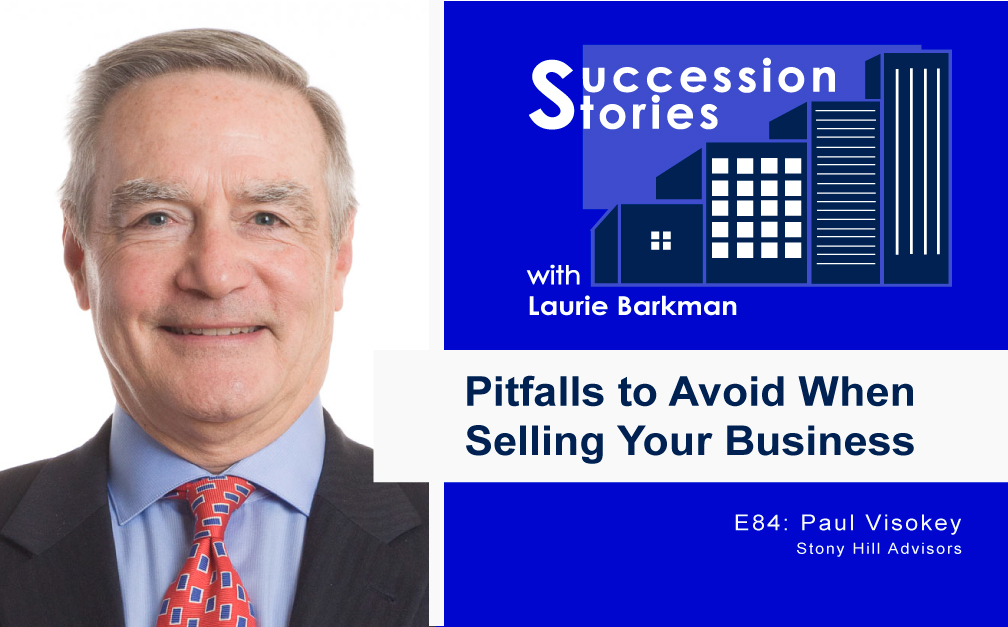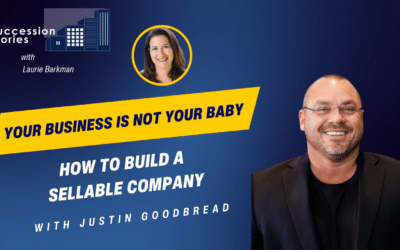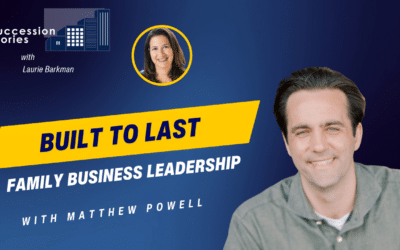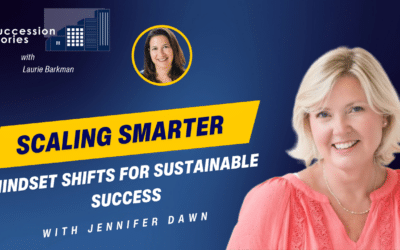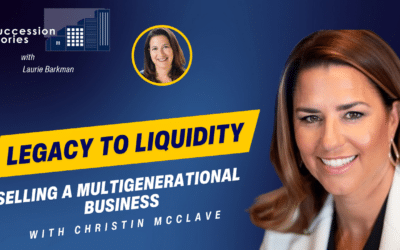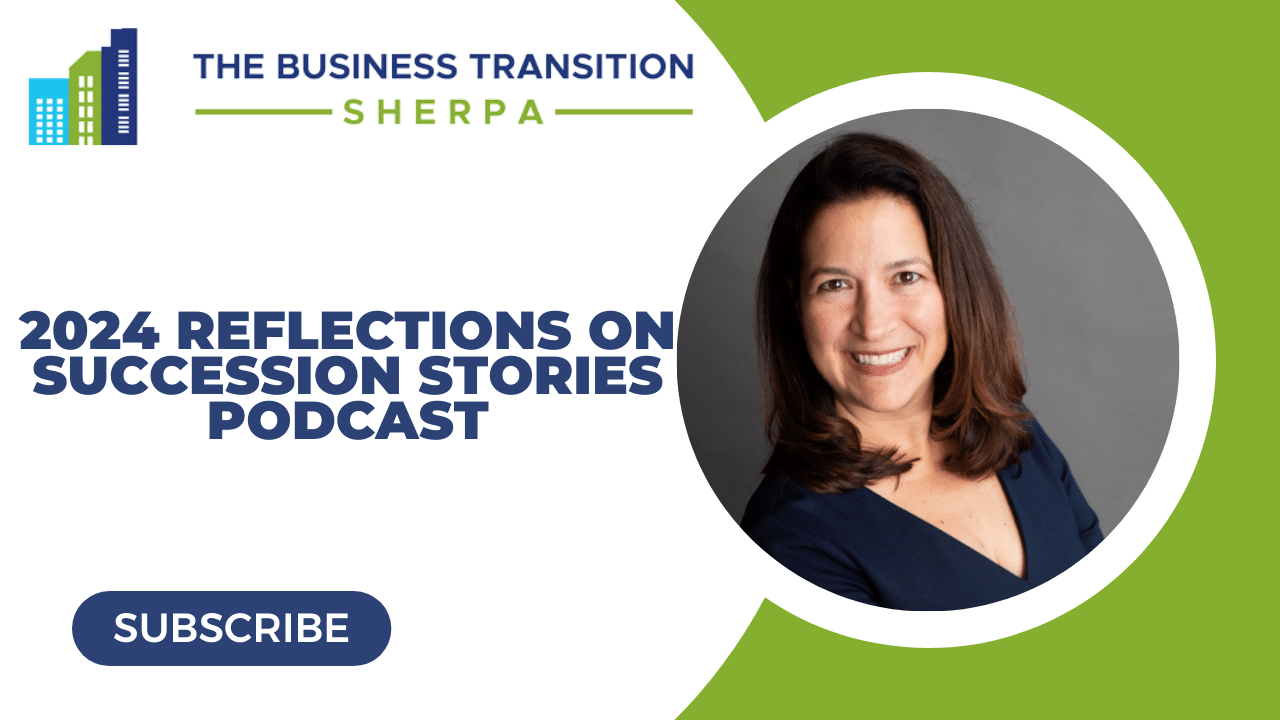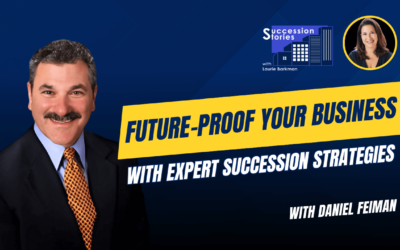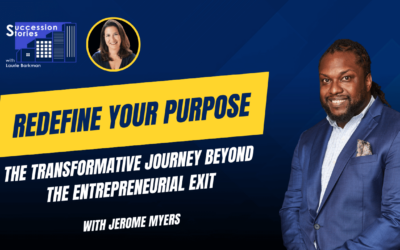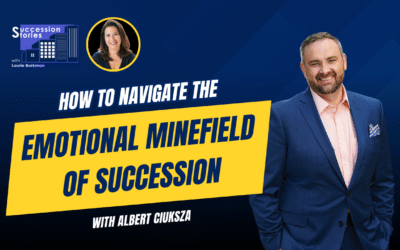Selling your business is one of the most important transactions of your life. But there are numerous pitfalls that can derail the M&A sales process. It’s an intensive undertaking that requires the right team of collaborators to guarantee success. Paul Visokey is the President of Stony Hill Advisors, specializing in transactions in the lower middle market. He returns to the Succession Stories Podcast and joins host Laurie Barkman to discuss the realities of selling – before, during, and after the process.
Listen in to learn more about:
- Navigating the private market when selling your company
- A detailed look at each stage of the selling process
- Understanding the lower middle market
- What the current economic situation means for M&A
- Getting your financial records in order
- Taking the guesswork out of business valuations
- Post M&A considerations
Show links:
- Download the Age Wave Whitepaper
- Episode 52 Paul Visokey, “Monetizing Your Business Through M&A”
- Episode 82 John Warrillow, “Selling Your Company”
- Episode 68 David Wible, “Value Creation Revenue and Subscription Businesses”
- paul@stonyhilladvisors.com
Don’t leave your exit to chance.
Stony Hill Advisors works with owners like you to get ready and maximize value when you’re ready to sell.
Visit www.stonyhilladvisors.com/podcast for a complimentary business valuation.
About Succession Stories Podcast
Succession Stories is hosted by Laurie Barkman, the Business Transition Sherpa– guiding business owners through the process from “transition to transaction.”
Learn more at https://thebusinesstransitionsherpa.com
Book a 1:1 Advisory call at:
We appreciate your support…subscribe, share, and post a review to share what you like about the show!
Transcript
Laurie Barkman:
This week I’m continuing the topic of selling your company, this time from the perspective of a mergers and acquisitions intermediary. Paul Visokey is the President of Stony Hill Advisors, specializing in transactions in the lower middle market. Last year, I teamed up with Paul and the great team at Stony Hill to serve business owners as an M&A Advisor. Our first conversation was episode 52 if you want to check it out. As a returning guest, Paul and I had a fantastic conversation about the process of selling and how to avoid common pitfalls. For anyone wondering why you would work with a buy-side or sell-side advisor, Paul shares golden nuggets to think about. By the way, if you haven’t yet listened to my conversation with John Warrillow in Episode 82, tee that one up next. These two episodes go together like peas and carrots to quote one of my favorite movies, Forrest Gump. Enjoy my conversation about avoiding pitfalls when selling your business with Paul Visokey.
Laurie Barkman:
Welcome back to Succession Stories, Paul. I’m excited to talk to you today, you know we’re celebrating our six month anniversary of working together, which is pretty cool so the audience might remember that you were on the show last year, roughly six months ago, and I think it’s awesome to have you back. I’m looking forward to our discussion today.
Paul Visokey:
I am as well. Six months, I didn’t realize was that long. I thought it was recent.
Laurie Barkman:
Yeah, we’ve been working together for six months so we should probably share with the audience. Some of them might…some of the folks listening might have heard the episode where I had you on the show, and I was really excited to announce that I had joined up forces with Stony Hill Advisors, which is your firm, to be a partner and working with small business owners in the lower middle market on mergers and acquisitions. You had found me, I guess the story, maybe let’s rewind, how did you even find me? How did you reach out? You reached out to me and said, “Hey, Laurie, I think you would be great to join the firm,” and I don’t know, let’s just talk about that.
Paul Visokey:
I was watching one of your podcasts on LinkedIn, then I clicked on and watch the whole video and what I heard was amazing and you really get the process of preparing a business for exit, and I reached out to you and said, “Wouldn’t you like to do the rest of the job and help them sell their business too,” and you hesitated, I kept staying in touch, because I knew you would be perfect for this role, because your background is you have the experience working in industry, in marketing and the personality to really relate to the business owner, so I knew you’d do a good job, just took me a long time to get you on board.
Laurie Barkman:
Thank you, and that speaks to your persistence. Well, thank you for sharing that and also, thanks for your persistence, because it was a great example of how to overcome objections in the sales process. You sure you demonstrated that, so why don’t we get started. We’re gonna have a conversation today to help the audience, help listeners understand some of the pitfalls to avoid when selling their company, and I thought the best way to start is let’s talk a bit about the private market. It’s not the public market, it’s not publicly traded companies, these are private companies, and a buyer and seller.
Just like when you’re buying a home, when you want to buy or sell a company, you have to put a price on it, you have to go through a process, but until you go through the process, it’s really hard to know what that looks like and feels like. You have more than 15 years, you probably have 20 years at this point, experience in the mergers and acquisition space, particularly in the lower middle market. Why don’t we start there? Why don’t you help us understand, what is the lower middle market? What does that mean? What are transaction sizes in this space? And let’s talk a little bit about some of the private market dynamics from 2021.
Paul Visokey:
Sure, well, the lower middle market is a definition that’s very loose. We focus on businesses with enterprise value from one to 20 million roughly and that excludes the main street markets and the pizza shop, and it includes the major corporations go to investment bankers and have a multimillion dollar transaction, and the banker gets multi million dollars as well, because that’s just full of people, support, and these are big corporations.
So in this middle zone, there’s just a lot of responsibility we take to help a business get ready, business owner and help them find a private buyer and because it’s not an illiquid market, like the public markets, the buyers are hard to find in some cases. Some businesses are a little more attractive than others but it takes a process to find them. It’s a lot of work and it takes time; we have probably a nine month average and sometimes much longer to find the right buyer.
Laurie Barkman:
You were recently at a conference where they talked a lot about 2021 in hindsight and looking forward to 2022. What’s the high level summary from the year? It was a banner year for activity in this space, wasn’t it?
Paul Visokey:
It certainly was. It was, I think, driven by a number of external factors. Partly the change of administration and the threat to raise capital gains taxes. As I mentioned, enterprise value of a million dollars that was way over the bottom limit of who would be hit with increased capital gains tax, so every one of our prospective clients was going to see a doubling of capital gains tax, and so they were rushing to, “If I’m going to sell I might as well sell now.”
That kind of wane, it’s literally at the very last day of the year, when the Build Back Better Act fell apart and what happened then is the momentum was already in motion, these people were already thinking about selling, they didn’t sell last year, they’re still looking to sell now, then you have the other factors, I think impacting small business owners, hiring people, now it’s so hard. They’re still dealing with supply chain issues and so it’s just, do they really want to keep doing this? They’re getting older as well, many, many of our clients or clients are baby boomer generation, in fact most are. So it’s just a combination of factors so 2022 can be a good year as well.
Laurie Barkman:
Let’s talk about the age wave. You wrote a white paper called The Age Wave white paper, and it’s a resource we can make available to the audience. We’ll put a link to it in the show notes for how people can get it and it’s a really good piece, it talks a lot about the demographics and never ever before have five generations been in the workforce, by the way, that is amazing and so the baby boomers, we we give them a lot of credit, right? They’ve done an amazing yeoman’s job to build so much in our country, build a lot of wealth in our country and now they’re at the point where there’s a transition happening.
It hasn’t happened, you’ve been talking about that the last couple minutes here and certainly for that demographic, it can be daunting, because it’s their whole life, right? They put their whole life into that business, they might have their name on the door, maybe they have a family member that wants to transition, maybe they don’t; a lot of people who do not then look for options, so in this conversation, as we talk about the getting ready part, there’s a personal side to getting ready, there’s a business side to getting ready.
One of the guests who was on my show, I just loved how he said it, David Wible, and I’ll put a link to his episode, what he said was, “You might be ready to sell but you might not be sell ready,” and so sometimes I know, Paul, you’ve seen this in your experience where, especially if it’s someone who is in their 60s or 70s, their time clock is shorter than someone who’s in their 50s or their 40s to sell the company, and they might not have a sell ready business have you? Have you encountered that pitfall?
Paul Visokey:
All the time. It’s funny, if you refer to my Age Wave white paper, too, I did some analysis on the statistics, but mostly Baby Boomer generation business owners, and they started in the 1970s to try to find a job — we had a major recession, early 70s — and then again in the early 80s and they couldn’t find corporate jobs so they started their own companies.
Now, fast forward to 2022. They’ve been in their companies for many years and what happens over time is you get comfortable with the risk factors that are embedded in any business. You don’t want to fix a machine, the key employees are the same age as you and they’re all looking to retire at the same time. Issues with your customer base that you got rid of the bad payers and haven’t really been advancing your marketing so you’re limited in your customer base, but it’s still a good customer base, but it’s a risk factor with some concentration, etc. There’s lots of these issues.
The most important is the owner is oftentimes — these are again, I mentioned, enterprise value a million to 20 million, the owner is very instrumental to every decision in the business and you can’t sell a business if the business is you. That’s the saleability issue mentioned, so we help a business owner, address the risk factors and most importantly, prepare the business for your exit. It could be hiring someone to replace you and you take some time off and I’ve said to people, “If you go away for a month in Florida for vacation, and no one knew you weren’t there, now your business is ready.” But also it’s just documentation and getting everything organized in advance.
The other factor people don’t think about is because we all think we’re impervious or never have anything happen. I’ve had many cases where a business owner came to me and said, “I have an illness, it’s cancer, it’s a heart attack.” It’s something that’s happening, that changes their perspective on how long they’re going to work and I’ve said to them, “When you’re sick, your business is going to be sick too and that’s a problem,” so getting the business ready in advance is so important and increases value dramatically. They don’t understand business. Those don’t typically understand how much leverage they have if the business is really de-risked and uptight and ready to go.
Laurie Barkman:
Exactly so there is a dynamic of when a person is thinking about their timeline, maybe it’s in we can put it in general buckets: ready now, within maybe a year, two to five years and then more than five years and I know both of us have examples we can think of where people are in each of those categories and it’s true, they do think about getting ready in a different way.
But based on what you just said, what are we really summarizing here? We’re saying it’s just good economics to get your business ready for a sale. Why? Because it’s all the things that are going to inherently increase its value, make it more easy to run and be more enjoyable and let’s face it, why wouldn’t you want to have more balance in your life, have other people running the day to day and having you step back and really work on the things that are important and key to the business? Easy to say, hard to do? I know, I know. I mean, we can sit here and talk about it all day but unless you’re in the trenches as the entrepreneur, it’s always hard to relate and be in their shoes.
As you mentioned, there have been a lot of crises with staffing challenges and supply chain issues and not to mention a little thing called the pandemic, it’s been a really tough couple of years so if someone’s also had health issues, you know, that can on top of it, further detract from the value make the business more risky. Why don’t we switch now we’ll and related to this as the process, you started talking about the process of getting ready, you and I call it exit value planning, you’ve alluded to some of those key steps and how we work with folks. So let’s jump into the next step, which is what I call pre diligence, pre diligence, pre diligence tees up what you were saying, which is in the Get Ready phase, it’s not just in your head, it’s documented. So what are some of the pitfalls here that you’ve seen, where a company just does not have financials documented well, or other aspects of the business documented?
Paul Visokey:
Certainly, the financials are key, because that’s what people are buying is return on investment and if they can’t trust your return on the business you’re running, because there’s all kinds of fluff in there, like personal expenses, vacations, homes, cars, those things have to be accounted for and adjusted for. The more of those things that exist, the more the buyer’s questioning more and more of a business so if you’re nearing a point where you might think about getting ready, you should clean up the business and get your financials in order. In our size target market, it should include a review from a CPA, too often it’s QuickBooks, and that’s all and poorly kept QuickBooks too because there’s no rhyme or reason to what they’re charging off on various things so that’s a cleanup that you need to do.
Then beyond that, it’s just getting your business documentation, due diligence ready and even if you’re not intending to sell your business in the near future. If it’s ready, when the time comes, you have less work to do in the midst of putting the business on the market. A buyer wants to know this, wants to know that, we’ve already done all the thinking of what I need to show them and have it ready, then you don’t have the stress factor of doing it under, running your business, keeping it confidential, which is important, and having a buyer ask for everything.
Laurie Barkman:
Yeah, there was just an example to share, I was doing outreach on behalf of a buyer. One of my clients was the buyer and I had done outreach and found a services company that might be interested in selling. Well, when I asked for the financials, the first answer was, “Oh, yeah, okay, my wife can get those reports out of our QuickBooks account.” Well, here we were 90 days later, and there was still the same answer, “Oh, she hasn’t had a chance to run the reports yet,” and eventually, I stopped following up, it clearly was not going to come my way for my client and we moved on and it seemed at the time, so straightforward. All she has to do is run reports. Well, why didn’t it happen? Ultimately, they weren’t ready to sell. They had other things happening with their family, a million reasons, right, but that’s just one example and it can get exacerbated very, very quickly when the deal gets larger and more complex, so the pre diligence phase is really important. So what’s the next thing? The next question people often ask is, “Well, what is my business worth?” And in the private market, it’s not easy to answer, right? There’s a million values for a privately held company, it’s in the eye of the buyer, right?
Paul Visokey:
There are methodologies that valuation experts use but in my opinion, it’s a process that is scientific, but ends up not meaning a lot other than that point in time, someone assumes a value, but in reality, what it’s worth is what someone will pay for and you don’t know that from the calculations you do to put a valuation on this so it’s good for your edification to know that, “Okay, I know my business is worth X.” It’s good for exit planning purposes. If it’s your primary method of retiring is, “Do I have enough value in my business to retire?” But it’s going to vary dramatically based on the buyer and In our market, a lot of our buyers are strategic buyers, therefore, they value the business very differently than the calculations would suggest so it’s, you really can’t depend on evaluation but it’s good to have it split that way.
Laurie Barkman:
And we should put it, we should just put a caveat on this, that if you’re in a legal dispute, if you’re using evaluation for estate purposes, there are reasons to get certified valuations and our discussion here we’re saying we help buyers in developing an estimate of value, market based estimate of value, including comps, just like if you’re buying a house, you want to get market comps, and we do that. But if you are trying to value a business because of a state plan, or other things where there’ll be perhaps litigation concerns, then you would want to look into getting a certified valuation, which is a completely different process but I don’t want to discount that there is a need for that for sure for certain times.
Paul Visokey:
When I get a call —
Laurie Barkman:
Yeah, go ahead.
Paul Visokey:
When I get a call about getting a valuation done, I always ask, “What’s the purpose?” Right? If it’s for legal purposes, you really need a certified valuation.
Laurie Barkman:
Yeah, and we have some tools for that and we also offer a service. Again, in the show notes, I’ll put some links there. If you’re interested in understanding what your business is worth, it’s a great place to start because what we want to do is look at what gaps might we have, right? If you’re ultimately trying to retire and have a nest egg of 10 million, and we value your business at four, well, you may have a gap unless your other investments are going to close that gap of six as an example so that’s why it’s important to just understand I like to say, “What ocean are you swimming in? What’s your ocean, your lake and your pond?” So understanding what your business might be worth to buyers is a good place to start and then seeing if there’s a gap so that if there’s a really big gap that kind of bounces us back to step one on the exit value planning, how might we increase the value of the business over time, and decreasing risk, increasing EBITDA, and profitability is a part of that.
Paul Visokey:
A word of caution: never trust somebody you know who sold their business and they told you they sold it for so much money that you can’t believe it. Don’t believe it.
Laurie Barkman:
There’s the math behind it. I do a workshop, which is a part of it, which is understanding how valuations work, and what the formula looks like and so number one is whenever someone says, “Oh, yeah, I sold my company for a three times multiple,” you have to say, “Of what?” Was it times revenue? Was it times seller discretionary earnings? Was it times EBITDA? Because those ratios can be very different and so step one is just going back to that, and again, challenging, not challenging their multiple, right, but to your point, challenging your own thinking that just because so and so got that multiple means you will too, it may not be, that may not happen, so that’s good point.
All right, so we’re going down the path now. We’ve done the valuation on our company and now we’re thinking about putting it on the market, so are we going to go about this on our own as a business owner? Is it a for sale by owner kind of situation just like a house? Am I going to sell my house on my own? Or am I going to work with an intermediary, a broker, an advisor? You can put whatever label you want on it. We like to call ourselves mergers and acquisitions intermediaries, because we’re providing a level of service. What do you think about that? What have you encountered? What are some of the pitfalls of some business owners who have gone about the For Sale By Owner path?
Paul Visokey:
Excellent question because most of our clients, as I said, the baby boomers have been in their business 30 years, they’ve never done this before, they have no expertise. You may sell three or four houses in your lifetime, you’re selling your business once, and it’s the most valuable asset you have, really, and you want to do it, especially if it’s the end of your career and you’re selling to retire. You want to get the best advice and do the best and get the best offer you can so to do it on your own is amazing. It’s just… that doesn’t make sense to me. In order to address that, and we get asked that sometimes where a potential seller has someone interested in buying their company who they were talking with, they’ll come to us and we offer facilitation services, we’ll help them execute the transaction with our advice and our oversight of what’s happening, including the valuation so they know what their business is worth and what they should be asking and so it really makes a difference. It’s important that you really don’t want to do this on your own or with just your accountant or your attorney. They can do part of the job, but there’s much more to it. We work collaboratively with accountants and attorneys, because we all have something to add to the process.
Laurie Barkman:
There’s a lot of time that goes into selling, there’s the back and forth, obviously, and communications and there’s also confidentiality. It’s hard to to know when to share with your team, you know, and who to pull in at the right time and then that’s, of course, a distraction to them, but you have to interest them at the right time so that can be a pitfall too, especially if you’re running a process on your own.
Paul Visokey:
It’s absolutely true. We’re often asked about, “What should I tell anybody that reports to me?”, and the answer is, well, “Depends really on how trustworthy they are to keep it quiet, and how necessary they are to stay on board. Sometimes I have a client, now he’s giving phantom stock, which is a piece of the action that if the business is sold, that he gets a part of the transaction value, because you need to keep him on board he’s going to stay on, you put a time on the churning of the phantom stock, like a year or two or three years so the buyer knows this key individual is going to stay involved in the business. Those are factors that come into play. That’s where the facilitation comes in. We analyze the circumstances around the transaction and help the client, the seller really make the best decisions along the way.
Laurie Barkman:
Yeah, for sure. The next phase, I’ll call it business development, it’s marketing the company, it’s putting together the materials that gives the potential buyers an understanding of very confidential information, they’re only going to get it after they’ve signed a nondisclosure. Then, again, in terms of managing a process, this is what we do, we put together a process on a roadmap and this phase is really, really important so we’re trying to understand who to sell the company to. If a seller has been thinking about this, and having conversations that may lead them to selling directly because they’ve had conversations with strategics, or maybe it’s a key vendor or something, then there’s been conversations about buying the business but when there have not been those conversations, we need to do some research, we need to figure out who these potential buyers might be. How long does that process take? How do we find the right buyer? How do we build the list? Why don’t we talk a little bit about some of the pitfalls in this phase?
Paul Visokey:
Absolutely. I mentioned earlier that we very often find strategic acquirers. There is always sometimes a potential for an economic buyer so there is a listing process, you can put the business on the market in a confidential way and let people find it, but that’s kind of posting and hoping that they find it. We actually identify like the interested buyers and it can be a competitor. In some cases, some clients don’t want they’re competitor, no, so we’ll make a list and sometimes it gets scratched. It can be a vertical market integration, if someone in your industry is making acquisitions, that’s helping them grow so they’re buying down and adding on to their company, which is often the case with private equity. There’s platforms and there’s add ons, they can meet a supplier who wants to ensure that they have customers for their products and services, and so on so we analyze the potential marketplace and use our tools and databases to identify the targets, we send them teasers which are again, like with the listing, it’s a nondescript kind of document, it doesn’t tell you who name the company and so on. We have to protect the confident confidentiality, but it’s enough to they might be interested in that, again, goes back to the NDA and starting a process with that potential buyer so there’s a number of avenues we take, depending on the type of business and the opportunity to find the right buyer but you have to understand the marketplace to be able to do that.
Laurie Barkman:
marketplace to be able to do that.
Absolutely, and it can take a decent amount of back and forth time, which again, is why having an intermediary is helpful, because I find in my experience now working with sellers, it takes them again away from their day to day, takes them away from their team, their focus, so it’s a lot that we put on ourselves and that’s a key part of the process. It was funny, there’s one of my clients, he was trying to determine why should he hire an M&A advisor and what he was told was, “Those are things you just don’t want to do,” she said to him as an advice, “You know, they’re providing a level of service of things that you just wouldn’t want to be doing,” and it’s not talking down what we do. It’s just means it’s very different from running your business day to day and he said, “I completely understand,” and now that I’ve been working with him, he told me that story because I think he appreciates what I’m doing for him and there’s a lot happening behind the scenes that he knows I’m doing on his behalf.
Let’s jump forward, we’re going to skip a couple of steps here and jump to the end, which is, alright, so after we find buyers, we start to get some indication of interest; term sheets, we get letters of interest, there’s a whole lot of work in that phase to evaluate these deals, negotiate the deals, and now we’ve come to the deal closing. Yay, right? We’ve got the bank involved, there’s lending. I mean, you and I are skipping over a lot of steps here to get to the last phase here. I think it’s important to talk about, we don’t want to just get you to a successful deal. We want it to be successful thereafter, right? So whether you’re a buyer or a seller, we want you to be successful and happy. Let’s talk about some of the post sale watch outs from the seller side, in particular, and it goes to how these deals can be structured. What are some of the expectations that a buyer might have in a transition? What are some of the deal terms that might be included to make sure that the transition is successful?
Paul Visokey:
Most of these occur in the negotiation, where there might be a mismatch on price where a buyer makes an offer, and the seller wants more, so you can close that gap with things like earnouts, and seller notes. Other aspects come up, non compete agreements, a compensation agreement that you’re going to stay on for X number of years, sometimes even a minority interest in in the acquirer’s business. We provide guidance on what is common and recommended in certain circumstances, because it’s important to understand, to kind of feel the difference in the attention of the negotiation to what if it’s an easy negotiation, then you can resolve these things quickly. If it’s a tense negotiation, then you’ve got to hold your ground and make sure you don’t get rolled over.
Then after the acquisition is completed, there are issues of integration and today, the human capital component of a transaction is becoming so important, and has to be thought of in advance of the closing but also afterwards, you have to have some, we have recommendations, certain people work with business owners but it’s on the acquirer side, but most of these integrating the two businesses. Again, in strategic sense, the buyer has a population of employees and the seller, so the population of employees and there might be overlap, or it might be different HR policies, and it might be just different compensation plans so they have to be merged together and that’s a tricky process, too so there’s a lot of work and this is not an easy job, from beginning to end.
Laurie Barkman:
No, it’s not easy and I read this, I recently went through the certification process with the Association of Mergers and Acquisitions Advisors, and it was a great education because I’m a continuous learner. I love it. It was hard work, but I loved getting the perspective of the instructors. One of the things that they talked about was, if you’re not thinking about integration until deal close, it’s too late. You really need to be thinking about integration at the strategy planning side, which is the very first step, how are you going to integrate this business? I think for you and I and others that we work with in this space, we’ve developed a really nice collaboration network, where we can make reference, we can make referrals to other professional service providers, particularly in this space where we don’t do post M&A work, right? We get you to that point but then that’s where our engagements typically stop and we can help bring in other experts who do focus on that and this is one example, right, where the post M&A integration needs to be successful. How do you think about human capital, systems integration, etc.? That’s another thing I think we, I know I try to do as a value add, is bringing in a collaboration of other advisors whether it’s tax, legal, right, don’t you agree?
Paul Visokey:
Absolutely. When I started the company 12 years ago, the idea was to be holistic, to have a relationship with a business owner years in advance of selling, helping them get ready, help them through the process, find the best buyer, then help make sure that that transaction, which is your legacy, is properly executed by the buyer that the integration is thought of in advance and its oversought with the right type of skill sets so that whole process is important, in my opinion, to be able to get referrals from prior clients and to be represented in the marketplace as being one of the best companies to seek.
Laurie Barkman:
Yeah, and I love working with clients to help guide them through this process and I know you do too. It’s been fun to talk to you about the process. I know it seems really intimidating. We’ve been talking about pitfalls but I think the reassurance is that look, it can be a very effective process. It’s just good to have people on your team that have been through this before and that can help you. Of course, we’re advocating for that collaboration and to not go it alone. You said at minimum, you’ve got to have a good attorney who’s been through this before, a tax accountant that can advise you and of course, we would advocate for having an M&A intermediary by your side too.
Paul Visokey:
Absolutely. Everybody has a role to play to make it successful and we work with the SEC, we get a lot of referrals from counsel attorneys, because we have good relationships in all the deals we work.
Laurie Barkman:
Yeah, for sure. All right. Let’s turn the tables back to you for Fun Street as my friend likes to call this side of an interview. Little fun street questions. What is something about you that I would be surprised to know?
Paul Visokey:
Going back, you might see a couple little footballs there but I played football in college and not a lot of people know that because it’s so long ago. I think people think I handled the other helmet, but that’s not the case.
Laurie Barkman:
Alright, favorite book or movie?
Paul Visokey:
I’m actually reading this book for the second time, and it’s called Do Not Split The Difference. It’s about negotiation and the author was an FBI negotiator and did a lot of work with hostage situations, but he applies it to business too. It really helps me understand when, as I’ve said through this meeting, negotiations and the key part of what we do .We provide the guidance and I know that from that experience, it’s really important to know the signals. One of the things that they talk about in the book is open ended questions. If it’s a yes or no, it doesn’t get you very far, that, how are you going to do this and so on so it gets people to respond in their thought process, not just one word answers, so it’s a well written book.
Laurie Barkman:
Excellent. What is something that you and your household do every day as a ritual?
Paul Visokey:
Every day… I work every day.
Laurie Barkman:
24/7
Paul Visokey:
Yeah, my kids are grown, I have six grandkids, so we spent a lot of time with them in various ways. They’re in ages where they’re in sporting events so we get to see that, and that’s a big part of what we do every day, is the grandkids.
Laurie Barkman:
That’s awesome. All right. I know I asked you last time you were on the show, but I’ll ask you again, if you have a favorite quote to share.
Paul Visokey:
It’s kind of a funny quote – doesn’t relate to the business too much, but a quote from Yogi Berra and he once said about a restaurant, no one goes there anymore. It’s too crowded so it kind of tells you just the juxtaposition of the idea of being crowded, not going there anymore.
Laurie Barkman:
Yeah. Well, that has other connotations now, with how we think about crowds. Paul, it’s been great to have you back on the show. I love the conversation. I hope that we gave our listeners a lot to think about and learn and of course, invite everyone to follow up directly with me anytime people can get in touch with me, but also if they want to get in touch with you, what is a great way to do that?
Paul Visokey:
Email is probably easy. It’s just my first name at Stony Hill advisors.com. S-T-O-N-Y and that’s probably the easiest way to reach out.
Laurie Barkman:
All right, and we’ll be sure to put that in the show notes as well. Paul, thanks so much for being with me today.
Paul Visokey:
Thank you, Laurie. Appreciate it.

